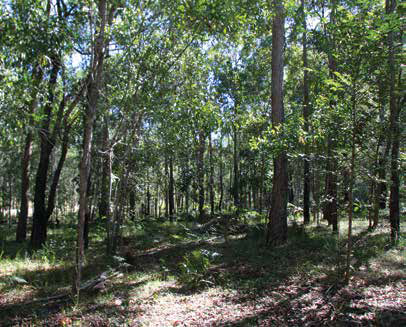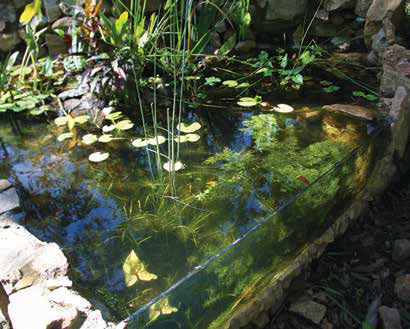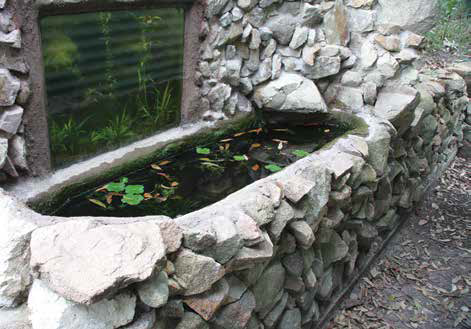Header: Some of the wildlife we have found on our property. Shown clockwise starting from the From Left: Roth’s Tree Frog (Litoria rothii); Green Tree Frogs (Litoria caerulea);Red Tree Frog (Litoria rubella); a rainforest scorpion
Our 40 acre property is in Captain Creek, about 20 km inland of the coastal tourist town of Agnes Water, South of Gladstone. We moved here about five years ago and shortly after joined Land for Wildlife. We decided to regenerate the bush rather than replanting cleared land as we knew that it would provide faster results for a healthier and broader diversity of plants and animals.

The property we chose had large areas of long established Lantana, with natives choking under it, and a variety of different vegetation zones including areas of Spotted Gum, turpentine and tall mixed eucalypt forests, as well as remnant rainforest. The main rainforest is located in a gully that traverses the property, and there are also other rainforest patches.


We decided on a hilly piece of land finding its contours appealing. The land varies from around ten degrees around the house, to around 24 degrees and very rocky on the slopes and creek beds. The lower slopes surrounding where we built support plants such as grass trees, Queensland Blue Gums, bloodwoods, turpentines, Rusty Kurrajongs, Brush Coral Trees, sandpaper gs, she-oaks, wattles, native hibiscus and rainforest species. The higher sections of the property are predominantly drier species including Spotted Gums.
Weeds we have encountered include Lantana, Billy Goat Weed, Corky Passionfruit, White Passionfruit, Snakeweed, various grasses such as Molasses Grass and many others weeds to a lesser extent. Lantana and Billy Goat Weed (Ageratum houstonianum) have been the most extensive and persistent weeds. We expect it to realistically take around 20 years to control the Lantana considering our other commitments.
We create weed heaps close to where we are working. They break down over time and create wildlife habitat and damp, shady zones that encourage plant growth. Many a weed pile has sprouted a native plant next to it.
Introduced grasses were one of the first weeds we tackled and we now have large areas of ground covered with native grasses such as Oplismenus sp., Ottochloa sp., and other grasses. The understorey is also full of native sedges, rattlepods, native ax (Dianella sp.), Shepherd’s Crook Orchid (also called the Pink Nodding Orchid, Geodorum densi orum), Plectranthus sp., Australian Bugle (Ajuga australis) and a variety of other creepers, ferns and herbs.
Some of the more interesting plants on our property include the Tree Zamia (Cycas megacarpa), Large-leaved Chain Fruit (Alyxia magnifolia) and Wedge-leaf Tuckeroo (Cupaniopsis shirleyana).
We retain logs and dead trees for natural breakdown and as homes for fauna. We use them to create gardens and paths, or leave them in situ in the less traversed areas. Large sticks are also used around emerging seedlings to protect from accidently being damaged. They have a similar effect as weed piles in encouraging plant growth near them and creating homes.
Our long-term goals are to remove all Lantana, continue to regenerate and expand the rainforest, and create inviting conditions for all fauna, with frogs a particular focus.
Sean (my partner) has built five ponds on our property, which is otherwise free of permanent water. Ponds have been built with rocks from our land, recycled glass sheets, an old bathtub and even
old dinghies. All have been built with the intention of minimising the entry of Cane Toads, encouraging frogs and running as self-sustaining ecosystems. Longer term, we will create ‘natural dams’ using existing watercourses.
The first two ponds built saw frogs breeding a few days after they were filled. Unfortunately (given my love of frogs), soon after the ponds were filled came the predators from up the food chain. Though disappointing that the frogs were being eaten, the ponds have improved the broader food web being a magnet for everything else. Fauna then aids in seed dispersal, so there are multiple benefits to having a permanent water source.
There is now nice regeneration around the seasonal creek that was once choked with Lantana. It was quite a slow process to start with, especially during dry periods, although each year there is less work as shade cover increases. Native plants prefer the conditions under a canopy and weeds are not so hard to control.
We have confirmed over 70 bird species at our place. There are a variety of macropods, antechinus, gliders, microbats, fruit bats, goannas, snakes, Mountain Brushtail Possums, bandicoots, native bees, rainforest scorpions, rainforest snails and more awaiting discovery.
We have around ten different species of frog here in an area that can be hot and dry for many months. We hope that on our property we can continue to increase our frog populations by providing lots of different environments and choices of water bodies, and continue to increase the biodiversity in general.
I started a social media group for my local area where we discuss, share photos, share ideas, share plants and help each other identify what we encounter on our properties. My hope is to encourage like- minded people to continue improving their natural environment by enjoying and understanding the things in it. Many people in our area come from ‘somewhere else’ and have had steep learning curves with identification of species. By sharing information, identification can be a lot faster, and fun.
Queensland has such amazing diversity and there are always so many new things to find.
Article and photos by Jolita Burneikis Land for Wildlife member Captain Creek, Agnes Waters
